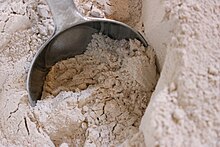
Whole-wheat flour (in the US) or wholemeal flour (in the UK) is a powdery substance, a basic food ingredient, derived by grinding or mashing the whole grain of wheat, also known as the wheatberry. Whole-wheat flour is used in baking of breads and other baked goods, and also typically mixed with lighter "white" unbleached or bleached flours (that have been treated with flour bleaching agent(s)) to restore nutrients (especially fiber, protein, and vitamins), texture, and body to the white flours that can be lost in milling and other processing to the finished baked goods or other food(s).